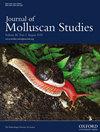Ceratal autotomy as a defensive mechanism of the sacoglossan sea slug Placida kingstoni against a generalist crustacean predator
IF 1.2
4区 生物学
Q2 MARINE & FRESHWATER BIOLOGY
引用次数: 0
Abstract
Sacoglossan sea slugs have developed a variety of defence mechanisms against predation. Research on these mechanisms has focused primarily on the chemical defences of these slugs, and little information is available on nonchemical modes of defence, such as autotomy, a behaviour in which an organism voluntarily detaches body structures at a predetermined breakage point in response to danger or stress. Autotomy is diverse in sacoglossan sea slugs and has been well documented. Within Oxynidae, members can autotomize their tail and parapodial lobes, and slugs in Limapontiidae and Hermaeidae can detach their cerata. More recently, reports have been made of Elysia with the capacity to autotomize most of their body. However, despite the widespread assumption that autotomy in this group serves a defensive purpose, the effectiveness of the behaviour in ensuring survival against predation has seldom been examined. The objective of this study was to evaluate the role of autotomy in sacoglossans by assessing the effectiveness of ceratal autotomy in ensuring survival against the attacks of a generalist predator. Placida kingstoni is a small sacoglossan native to Florida and the Caribbean with the ability to autotomize its cerata. Individual P. kingstoni were exposed to shrimps of the Lysmata wurdemanni species complex for 10-min interactions. Most sea slugs were attacked by the predator, often more than once, but the majority of the slugs readily autotomized cerata and survived. Structure detachment was accompanied by the secretion of a mucus that facilitated the formation of ceratal clumps. Most of these clumps were consumed by the predator and effectively diverted their attention, allowing P. kingstoni to crawl away. In this species, the success of autotomy as a defensive strategy appears to be directly related to the palatability of autotomized cerata. The results of this study show that ceratal autotomy in P. kingstoni is an effective defence against predation. Autotomy is a behaviour with a high-energetic cost; however, it has convergently evolved within Heterobranchia on multiple occasions, and it is highly prevalent in cerata-bearing slugs. Although in sacoglossans much of this behaviour remains a mystery, this study provides a clear example of autotomy as a defensive mechanism.角体自割作为沙舌海蛞蝓Plascida kingstoni对抗多面性甲壳类动物捕食者的防御机制
Sacoglossan海蛞蝓已经发展出各种防御机制来抵御捕食。对这些机制的研究主要集中在这些蛞蝓的化学防御上,关于非化学防御模式的信息很少,例如自残,即生物体在预先确定的断裂点自愿分离身体结构以应对危险或压力的行为。自切术在囊舌海蛞蝓中是多种多样的,并且已经有充分的记录。在Oxynidae科中,成员可以自我切割尾巴和副足瓣,Limapontidae和Hermaidae科的蛞蝓可以分离它们的角。最近,有报道称Elysia有能力对其大部分身体进行自我绝育。然而,尽管人们普遍认为这一群体的自残具有防御目的,但这种行为在确保生存免受捕食方面的有效性却很少被研究。本研究的目的是通过评估角部自残在确保生存免受广泛捕食者攻击方面的有效性,来评估自残在sacoglosans中的作用。kingstoni Placida是一种原产于佛罗里达州和加勒比海地区的小型sacoglossan,具有使其角鲨自我交配的能力。将金氏假单胞菌个体暴露于武氏溶胞菌物种复合物的虾中10分钟的相互作用。大多数海蛞蝓都会受到捕食者的攻击,通常不止一次,但大多数海蛞蛞蝓很容易自我交配并存活下来。结构的脱离伴随着粘液的分泌,这种粘液促进了角丛的形成。这些团块中的大部分被捕食者吃掉,并有效地转移了它们的注意力,使金氏P.得以爬行离开。在该物种中,自残作为一种防御策略的成功似乎与自残角鲨的适口性直接相关。这项研究的结果表明,金氏锥虫的角自残是一种有效的防御捕食的方法。自残是一种能量消耗很高的行为;然而,它在异鳃亚门内多次趋同进化,并且在产角鲨的蛞蝓中非常普遍。尽管在sacoglossans中,这种行为的大部分仍然是个谜,但这项研究提供了一个明确的例子,说明自残是一种防御机制。
本文章由计算机程序翻译,如有差异,请以英文原文为准。
求助全文
约1分钟内获得全文
求助全文
来源期刊

Journal of Molluscan Studies
生物-动物学
CiteScore
3.00
自引率
8.30%
发文量
36
审稿时长
3 months
期刊介绍:
The Journal of Molluscan Studies accepts papers on all aspects of the study of molluscs. These include systematics, molecular genetics, palaeontology, ecology, evolution, and physiology. Where the topic is in a specialized field (e.g. parasitology, neurobiology, biochemistry, molecular biology), submissions will still be accepted as long as the mollusc is the principal focus of the study, and not incidental or simply a convenient experimental animal. Papers with a focus on fisheries biology, aquaculture, and control of molluscan pests will be accepted only if they include significant advances in molluscan biology. While systematic papers are encouraged, descriptions of single new taxa will only be considered if they include some ‘added value’, for example in the form of new information on anatomy or distribution, or if they are presented in the context of a systematic revision or phylogenetic analysis of the group.
 求助内容:
求助内容: 应助结果提醒方式:
应助结果提醒方式:


